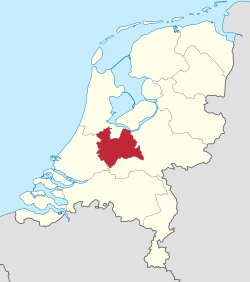Utrecht province
| Utrecht | |||
|---|---|---|---|
| Province of the Netherlands | |||
|
|||
| Anthem: Langs de Vecht en d'oude Rijnstroom | |||
 Location of Utrecht in the Netherlands |
|||
| Coordinates: 52°6′12″N 5°10′45″E / 52.10333°N 5.17917°ECoordinates: 52°6′12″N 5°10′45″E / 52.10333°N 5.17917°E | |||
| Country | Netherlands | ||
| Capital | Utrecht | ||
| Government | |||
| • King's Commissioner | Willibrord van Beek (VVD) | ||
| Area | |||
| • Land | 1,386 km2 (535 sq mi) | ||
| • Water | 63 km2 (24 sq mi) | ||
| Area rank | 12th | ||
| Population (2014) | |||
| • Land | 1,253,672 | ||
| • Rank | 5th | ||
| • Density | 900/km2 (2,300/sq mi) | ||
| • Density rank | 3rd | ||
| ISO 3166 code | NL-UT | ||
| Website | www.provincie-utrecht.nl | ||
Utrecht (Dutch pronunciation: [ˈytrɛxt]) is a province of the Netherlands. It is located in the centre of the country, bordering the Eemmeer in the north, the province of Gelderland in the east, the river Rhine in the south, the province of South Holland in the west and the province of North Holland in the north-west. With an area of approximately 1,400 square kilometres (540 sq mi), it is the smallest of the twelve provinces. Apart from its eponymous capital, major cities in the province are Amersfoort, Houten, Nieuwegein, Veenendaal, IJsselstein and Zeist.
In the International Organization for Standardization world region code system Utrecht makes up one region with code ISO 3166-2:NL-UT.
The Bishopric of Utrecht was established in 695 when Saint Willibrord was consecrated bishop of the Frisians at Rome by Pope Sergius I. With the consent of the Frankish ruler, Pippin of Herstal, he settled in an old Roman fort in Utrecht. After Willibrord's death the diocese suffered greatly from the incursions of the Vikings. Better times appeared during the reign of the Saxon emperors, who frequently summoned the Bishops of Utrecht to attend the imperial councils and diets. In 1024 the bishops were made Princes of the Holy Roman Empire and the new Prince-Bishopric of Utrecht was formed. In 1122, with the Concordat of Worms, the Emperor's right of investiture was annulled, and the cathedral chapter received the right to elect the bishop. It was, however, soon obligated to share this right with the four other collegiate chapters in the city. The Counts of Holland and Guelders, between whose territories the lands of the Bishops of Utrecht lay, also sought to acquire influence over the filling of the episcopal see. This often led to disputes and consequently the Holy See frequently interfered in the election. After the middle of the 14th century the popes repeatedly appointed the bishop directly without regard to the five chapters.
...
Wikipedia


